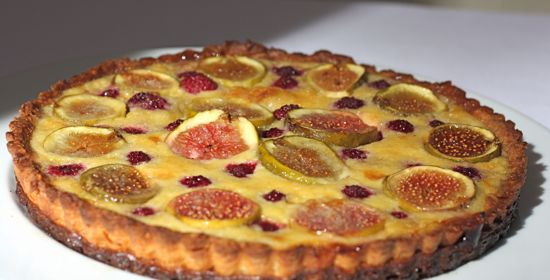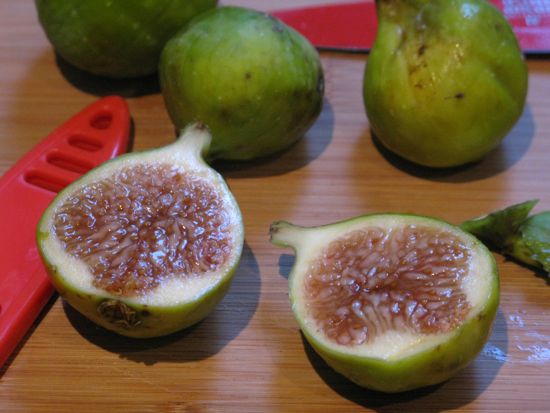
For years, I avoided figs at all cost. My childhood memories of throwing rotten fruit that had fallen from the tree in my best friend’s yard tainted any thoughts of actually eating one. As far as I was concerned, figs were gushy, sticky and positively repulsive.
Then, as an adult and a food writer at that, I felt compelled to at least try one of these fruits that so many others had described as utterly ambrosial. Plucked right off the tree, it was perfectly ripe and felt like a miniature water balloon in my hand.
I was a convert at first bite. The flavor was mild and sweet as honey with faint undertones of vanilla. The pink inner flesh glowed like a jewel. It was silky and soft, all but melting in my mouth, and the seeds popped between my teeth like caviar.
It’s amazing how much difference it makes to eat fruit in its time.
Now I know why some people suggest the forbidden fruit Eve nibbled in the Garden of Eden really was a fig. Few fruits are as sensual.
As irresistible as ripe figs are eaten out of hand, they lend themselves beautifully to cooking. Figs wrapped in prosciutto and grilled have become a fall classic on Bay Area restaurant menus. I particularly like them in this tart, where bright raspberries play counterpoint to luxuriously rich figs set against a background of custard spiked with cognac. The almond inflected crust is tender and flaky.
Although it looks complicated, the dough comes together quickly in a food processor. And you can divide the work into steps, making the crust one day and the custard another.
One trick I picked up from Rose Levy Beranbaum’s “The Pie and Pastry Bible” (Scribner, 1998) for transferring the rolled dough smoothly to the tart pan is to use an 8-inch cake pan. Turn the cake pan bottom up and drape the dough, still between sheets of plastic wrap, centered over the pan. Peel off the upper layer of plastic and invert the tart pan over the dough. Holding the cake pan and tart pan together, quickly flip them over. Ta da! The dough is is in the tart pan without tearing. Carefully remove the remaining layer of plastic and you’re ready to trim and chill.
 I used the green-skinned Kadota figs now in season for this tart, but you’ll probably find black Mission figs in the market, too. Brown Turkey figs could be available into November if the weather stays warm. We Californians are lucky that most of the U.S. crop is grown within the Golden State.
I used the green-skinned Kadota figs now in season for this tart, but you’ll probably find black Mission figs in the market, too. Brown Turkey figs could be available into November if the weather stays warm. We Californians are lucky that most of the U.S. crop is grown within the Golden State.
When you’re picking the fruit, remember that ripe figs are not all beautiful from the outside. They tend to be a little wrinkly, maybe with a few splits on the sides. They should be soft and heavy and there may be a little drop of thick juice at the end. Just avoid those with a sour smell or any signs of molding or bruising.
If your figs are still slightly under-ripe, you can soften them slightly by placing them on a plate on the kitchen counter, out of direct sun, for a day or so. Ripe fresh figs, though, should be stored, covered, in the refrigerator on a plate lined with paper towels. Eat within two or three days.
Makes one 9 ½ -inch or 10-inch tart
For crust:
¼ cup sliced almonds
¼ cup powdered sugar
1 cup all-purpose flour
Pinch salt
6 tablespoons unsalted butter
1 extra-large egg, separated
1 tablespoon heavy cream
For tart:
8-10 medium fresh figs
About ½ cup raspberries
2 eggs
1 cup heavy cream
¼ cup granulated sugar
1 teaspoon vanilla
1 tablespoon cognac
Pinch of salt
Make the crust: In the work bowl of a food processor, whirl together sliced almonds and powdered sugar until nuts are finely ground. Add flour and salt and pulse a couple of times until blended. Cut butter into small pieces and add to flour and nut mixture in processor. Whirl until butter pieces are the size of small peas. In a measuring cup, whisk together egg yolk and cream, reserving egg white for later use. With processor running, pour egg and cream mixture through feed tube and whirl just until the dough starts to come together in a ball.
Gather dough up in a large piece of plastic wrap, flatten ball into a disc, wrap tightly and refrigerate for ½-1 hour. Dough should be firm but not rock hard before rolling. Sprinkle flour on both sides of the chilled dough and roll out between two pieces of plastic wrap into a 12-inch circle about 1/8-inch thick. Transfer to fluted tart pan with removable bottom and trim excess dough to fit pan. Cover loosely with plastic wrap and return to refrigerator to chill at least one hour. (At this point, the crust can be wrapped tightly and frozen for baking at a later time. Crusts that have been frozen for at least six hours do not need to be weighted for baking as described in the next step.)
Preheat oven to 400 degrees. Line the unbaked tart shell with a sheet of parchment paper and fill with pie weights or a pound of dried beans. Bake 15 minutes, until set and carefully lift out the paper and weights. Prick the bottom of the crust a few times with a fork and return crust to oven for 10-15 minutes more, until golden brown all over. Meanwhile, beat the reserved egg white in a small bowl with a tablespoon of water. Remove baked crust from oven and let cool for about 3 minutes on a wire rack. Brush a thin layer of the beaten egg white over the bottom to seal the crust against moisture. Let cool completely before you prepare the filling.
Make the filling: Place tart pan on a baking sheet. Rinse and gently pat dry the figs and raspberries. Remove stems from figs and slice in half lengthwise. Arrange in a decorative pattern in the tart shell. Fill between the figs with raspberries. In a medium bowl, beat together the eggs, cream, sugar, vanilla, cognac and salt. Pour this mixture over the fruit in the shell. (Note: Depending on the size of the tart, you may end up with leftover custard. Just pour it into a buttered, heatproof cup and bake alongside the tart.)
Bake for about 30 minutes, until the custard puffs up and begins to brown. You may need to cover the edges of the crust with strips of aluminum foil to protect against burning.
Let cool and serve.
Aleta Watson
